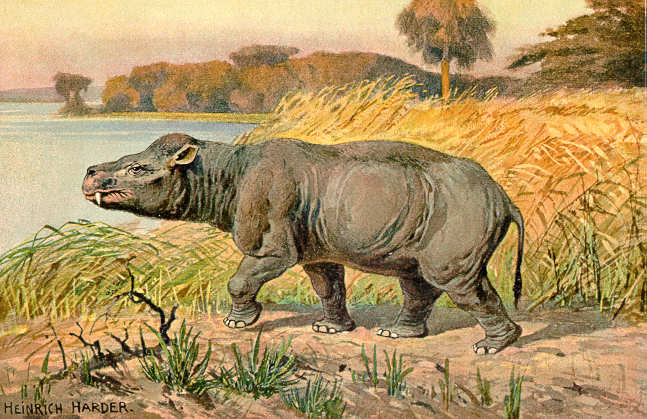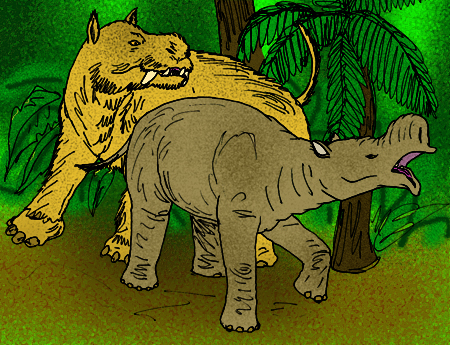|
Coryphodon
''Coryphodon'' (from Greek κορῦφὴ, "point", and ὀδοὺς, "tooth", meaning ''peaked tooth'', referring to "the development of the angles of the ridges into points n the molars") is an extinct genus of pantodonts of the family Coryphodontidae. ''Coryphodon'' was a pantodont, a member of the world's first group of large browsing mammals. It migrated across what is now northern North America, replacing ''Barylambda'', an earlier pantodont. It is regarded as the ancestor of the genus '' Hypercoryphodon'' of Late Eocene Mongolia. ''Coryphodon'' is known from many specimens in North America and considerably fewer in Europe, Mongolia, and China. It is a small to medium-sized coryphodontid who differs from other members of the family in dental characteristics. Description At about at shoulder height and in body length, ''Coryphodon'' is one of the largest-known mammals of its time. The creature was very slow, with long upper limbs and short lower limbs, which were nee ... [...More Info...] [...Related Items...] OR: [Wikipedia] [Google] [Baidu] |
Coryphodontidae
Coryphodontidae is an extinct family of pantodont mammals known from the Late Paleocene to the Middle Eocene of Eurasia and North America. The type genus ''Coryphodon'' is known from around the Paleocene-Eocene transition in Europe, western United States, northern Canada, and eastern Asia. The remaining genera are known exclusively from the middle Eocene of Asia. The coryphodontids are related to the pantolambdids. ''Coryphodon'' are large, derived pantodonts first described in the mid-19th century, but no intermediate stages leading to their unusual upper molars are known. The last known species of ''Coryphodon'' have bilophodont molars similar to later, more derived coryphodontids, and, most likely, ''Coryphodon'' is the primitive sister taxon to the remaining genera and the entire lineage (or lineages) originated from within this genus. Two coryphodontids considerably larger than ''Coryphodon'' but endemic to China, '' Asiocoryphodon'' and '' Heterocoryphodon'', have more ... [...More Info...] [...Related Items...] OR: [Wikipedia] [Google] [Baidu] |
Pantodont
Pantodonta is an extinct suborder (or, according to some, an order) of eutherian mammals. These herbivorous mammals were one of the first groups of large mammals to evolve (around 66 million years ago) after the end of the Cretaceous. The last pantodonts died out at the end of the Eocene (around 34 million years ago). Pantodonta include some of the largest mammals of their time, but were a diversified group, with some primitive members weighing less than and the largest more than . The earliest and most primitive pantodonts, ''Bemalambda'' (with a skull probably the size of a dog) and '' Hypsilolambda'', appear in the early Paleocene Shanghuan Formation in China. All more derived families are collectively classified as Eupantodonta. The pantodonts appear in North America in the middle Paleocene, where ''Coryphodon'' survived into the middle Eocene. Pantodont teeth have been found in South America (''Alcidedorbignya'') and Antarctica, and footprints in a coal mine on Sval ... [...More Info...] [...Related Items...] OR: [Wikipedia] [Google] [Baidu] |
Pantodonts
Pantodonta is an extinct suborder (or, according to some, an order) of eutherian mammals. These herbivorous mammals were one of the first groups of large mammals to evolve (around 66 million years ago) after the end of the Cretaceous. The last pantodonts died out at the end of the Eocene (around 34 million years ago). Pantodonta include some of the largest mammals of their time, but were a diversified group, with some primitive members weighing less than and the largest more than . The earliest and most primitive pantodonts, ''Bemalambda'' (with a skull probably the size of a dog) and '' Hypsilolambda'', appear in the early Paleocene Shanghuan Formation in China. All more derived families are collectively classified as Eupantodonta. The pantodonts appear in North America in the middle Paleocene, where '' Coryphodon'' survived into the middle Eocene. Pantodont teeth have been found in South America (''Alcidedorbignya'') and Antarctica, and footprints in a coal mine on Sv ... [...More Info...] [...Related Items...] OR: [Wikipedia] [Google] [Baidu] |
Eocene Mammals Of Europe
The Eocene ( ) Epoch is a geological epoch that lasted from about 56 to 33.9 million years ago (mya). It is the second epoch of the Paleogene Period in the modern Cenozoic Era. The name ''Eocene'' comes from the Ancient Greek (''ēṓs'', "dawn") and (''kainós'', "new") and refers to the "dawn" of modern ('new') fauna that appeared during the epoch. The Eocene spans the time from the end of the Paleocene Epoch to the beginning of the Oligocene Epoch. The start of the Eocene is marked by a brief period in which the concentration of the carbon isotope 13C in the atmosphere was exceptionally low in comparison with the more common isotope 12C. The end is set at a major extinction event called the ''Grande Coupure'' (the "Great Break" in continuity) or the Eocene–Oligocene extinction event, which may be related to the impact of one or more large bolides in Siberia and in what is now Chesapeake Bay. As with other geologic periods, the strata that define the start and end of t ... [...More Info...] [...Related Items...] OR: [Wikipedia] [Google] [Baidu] |
Eocene Mammals
The Eocene ( ) Epoch is a geological epoch that lasted from about 56 to 33.9 million years ago (mya). It is the second epoch of the Paleogene Period in the modern Cenozoic Era. The name ''Eocene'' comes from the Ancient Greek (''ēṓs'', "dawn") and (''kainós'', "new") and refers to the "dawn" of modern ('new') fauna that appeared during the epoch. The Eocene spans the time from the end of the Paleocene Epoch to the beginning of the Oligocene Epoch. The start of the Eocene is marked by a brief period in which the concentration of the carbon isotope 13C in the atmosphere was exceptionally low in comparison with the more common isotope 12C. The end is set at a major extinction event called the ''Grande Coupure'' (the "Great Break" in continuity) or the Eocene–Oligocene extinction event, which may be related to the impact of one or more large bolides in Siberia and in what is now Chesapeake Bay. As with other geologic periods, the strata that define the start and ... [...More Info...] [...Related Items...] OR: [Wikipedia] [Google] [Baidu] |
Hypercoryphodon
''Hypercoryphodon'' is an extinct genus of rhinoceros-sized pantodont native to Late Eocene Mongolia, and was very similar to its ancestor, ''Coryphodon ''Coryphodon'' (from Greek κορῦφὴ, "point", and ὀδοὺς, "tooth", meaning ''peaked tooth'', referring to "the development of the angles of the ridges into points n the molars") is an extinct genus of pantodonts of the family Coryph ...''. Described from a skull, ''Hypercoryphodon'' is a quadrupedal hippopotamus-like herbivore that may have been able to adapt its feeding to suit different situations. It is thought to have possibly lived in wetland to forest ecosystems that it might have shared with other herbivores such as dinoceratans like ''Gobiatherium''.Osborn, H. F., & Granger, W. (1932)Coryphodonts and uintatheres from the Mongolian Expedition of 1930 ''American Museum Novitates''; no. 552. References External linksat Okapiland Pantodonts Eocene mammals Fossils of Mongolia Fossil taxa described in ... [...More Info...] [...Related Items...] OR: [Wikipedia] [Google] [Baidu] |
Eocene
The Eocene ( ) Epoch is a geological epoch that lasted from about 56 to 33.9 million years ago (mya). It is the second epoch of the Paleogene Period in the modern Cenozoic Era. The name ''Eocene'' comes from the Ancient Greek (''ēṓs'', " dawn") and (''kainós'', "new") and refers to the "dawn" of modern ('new') fauna that appeared during the epoch. The Eocene spans the time from the end of the Paleocene Epoch to the beginning of the Oligocene Epoch. The start of the Eocene is marked by a brief period in which the concentration of the carbon isotope 13C in the atmosphere was exceptionally low in comparison with the more common isotope 12C. The end is set at a major extinction event called the ''Grande Coupure'' (the "Great Break" in continuity) or the Eocene–Oligocene extinction event, which may be related to the impact of one or more large bolides in Siberia and in what is now Chesapeake Bay. As with other geologic periods, the strata that define the start and e ... [...More Info...] [...Related Items...] OR: [Wikipedia] [Google] [Baidu] |
Clarkforkian
The Clarkforkian North American Stage, on the geologic timescale, is the North American faunal stage according to the North American Land Mammal Ages chronology (NALMA), typically set from 56,800,000 to 55,400,000 years BP lasting . Considered to be within the Paleocene, more specifically the Late Paleocene, the Clarkforkian shares its upper boundary with the Thanetian. The Clarkforkian is preceded by the Tiffanian and followed by the Wasatchian NALMA stages. Substages It is considered to contain the following substages: *Cf3: (shares the upper boundary) and lower boundary source of the base of Clarkforkian (approximate) and upper boundary source of the base of the Ypresian (approximate). *Cf2: Is the lower boundary source of the base of the Clarkforkian (approximate) *Cf1: Upper boundary source of the base of the Ypresian (approximate) Fauna Notable mammals Multituberculata - non-therian mammals * '' Ectypodus'', neoplagiaulacid multituberculate Metatheria - mars ... [...More Info...] [...Related Items...] OR: [Wikipedia] [Google] [Baidu] |
Wasatchian
The Wasatchian North American Stage on the geologic timescale is the North American faunal stage according to the North American Land Mammal Ages chronology (NALMA), typically set from 55,400,000 to 50,300,000 years BP lasting . It is usually considered to be within the Eocene, more specifically the Early Eocene. The Wasatchian is preceded by the Clarkforkian and followed by the Bridgerian NALMA stages. Definition The age is named after the Wasatch Formation, a highly fossiliferous stratigraphic unit stretching across six of the United States from Idaho and Montana in the north through Utah and Wyoming to Colorado and New Mexico ) , population_demonym = New Mexican ( es, Neomexicano, Neomejicano, Nuevo Mexicano) , seat = Santa Fe, New Mexico, Santa Fe , LargestCity = Albuquerque, New Mexico, Albuquerque , LargestMetro = Albuquerque metropolitan area, Tiguex , Offi ... in the south. Substages The Wasatchian is considered to contain the following substages: * S ... [...More Info...] [...Related Items...] OR: [Wikipedia] [Google] [Baidu] |




